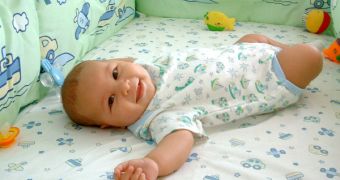Undergraduate students at the University of Florida (UF) developed a new wireless technology-based sensor that could detect the up-and-down movements of a baby's chest while sleeping. If the infant stops breathing or gulps for air, the device emits a warning signal, notifying the parents that something is wrong. The system uses a highly-refined version of the Doppler radar system, which is usually employed by the military in detecting enemy soldiers through walls.
This type of parental supervision on small children is far more effective than usual sensors, which only transmit video or audio feeds, meaning that parents have to be watching their receivers, in order to acknowledge that something is wrong. Because of the wireless technology they employ, the new sensors are far more useful, as the receivers the parents carry will trigger a distinct alert sound, if something is to go wrong. The researchers say that the technology could also cause a drop in the incidence of SIDS cases.
The device has four LED lights, which display information about the baby's breathing status, the level of current in the battery and the strength of the wireless connection. If anything is to go critical, different tones urge the parents to take action. "It's a step beyond just watching the baby through a video link or hearing it cry," says UF professor of electrical and computer engineering, Jenshan Lin, the leader of the research on the Doppler radar.
He adds that "It's the same Doppler radar that police use to catch speeders, but in our case, we don't measure constant speed, but rather back-and-forth motion — sort of like vibration. That's the fundamental principle of this technology."
The concept has multiple applications, but the most important one is creating a similar version that could detect heartbeats and their rates. This would also benefit seniors, as the researchers say that, with corporate funding, the device could be compacted to the size of a microchip, which would allow for it to be attached to mobile phones. Adults could keep an "eye" out for those old people who live alone, away from hospitals or other care centers.

 14 DAY TRIAL //
14 DAY TRIAL //